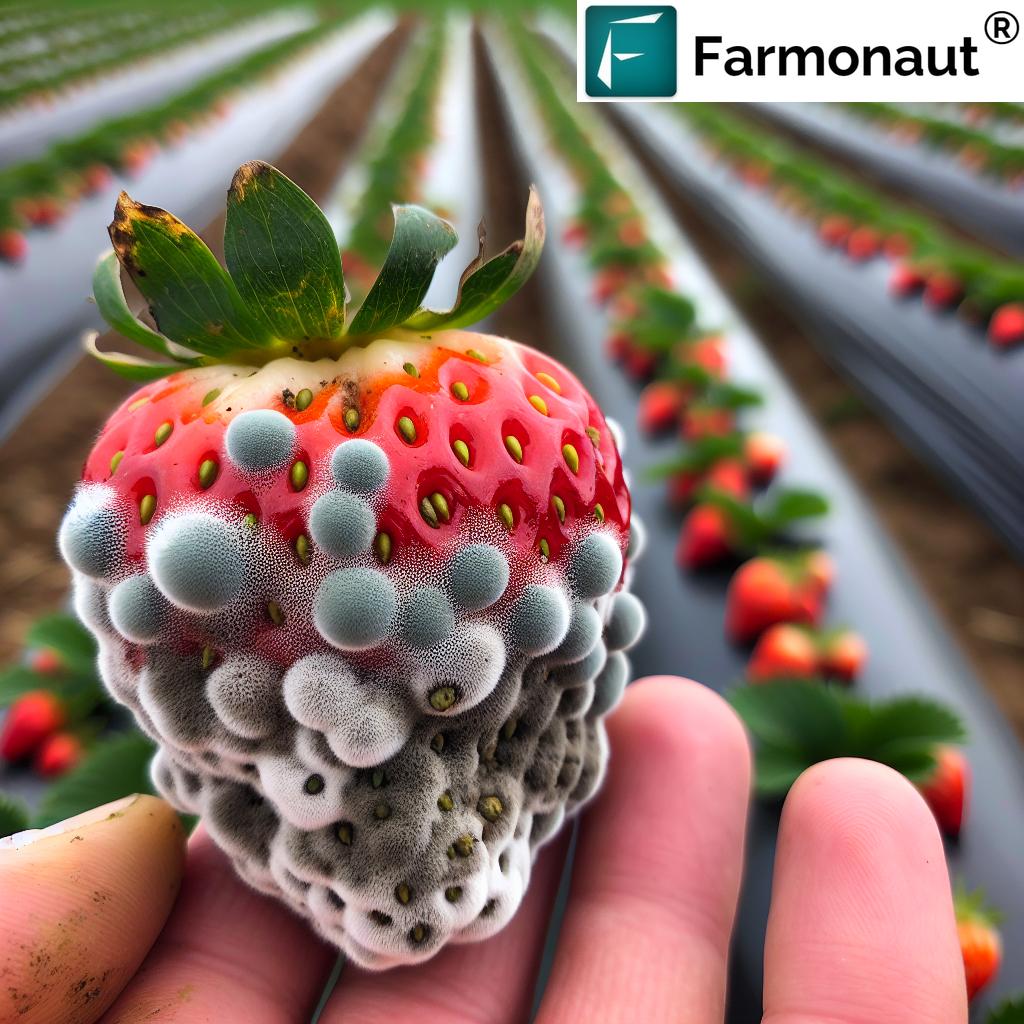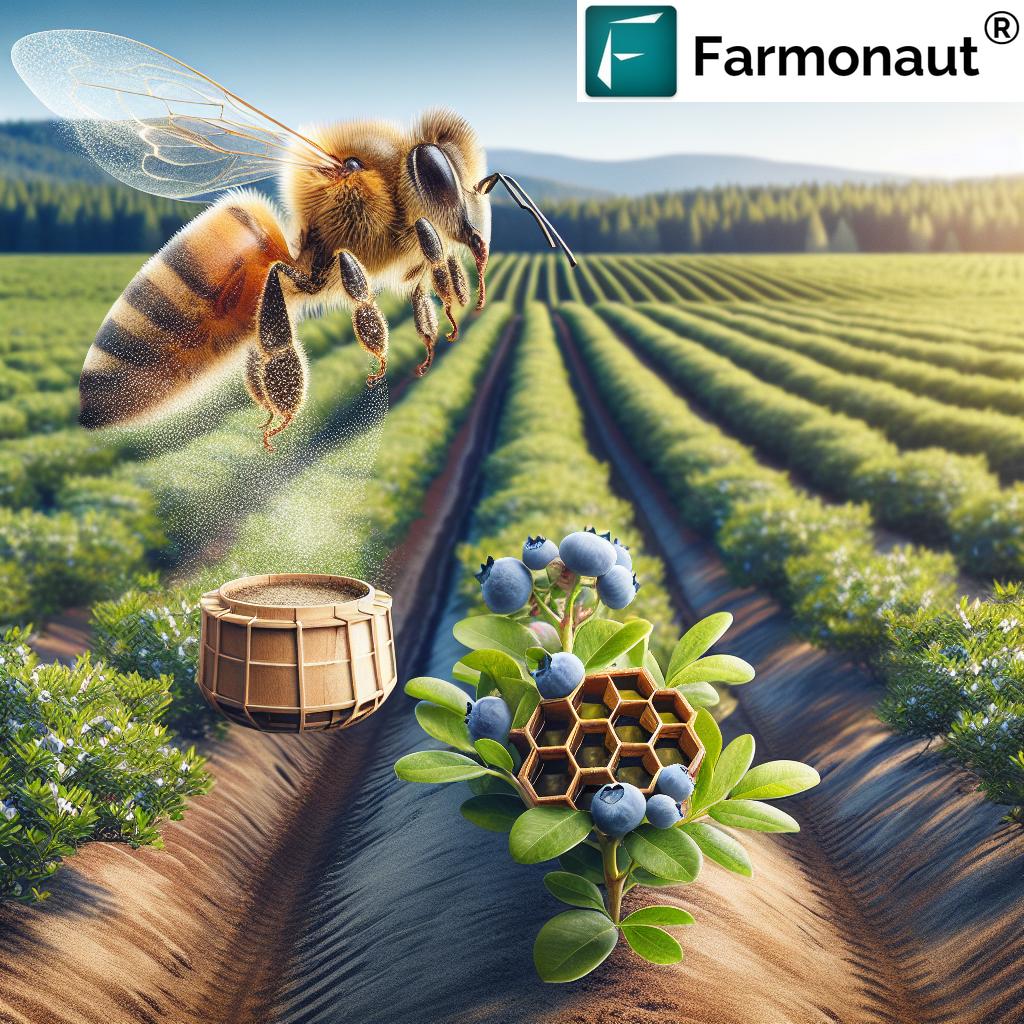Table of Contents
- Introduction: Soybean Farming and the Battle Against Bean Diseases in 2025
- Soybean Cultivation and Its Significance in India and Beyond
- Bean Diseases: The Persistent Threat in Soybean Farms
- The Integration of Indian Cork Tree and Indian Bean Tree in Sustainable Soybean Farms
- Role of Precision Bean Sprayers in Modern Crop Protection
- Farmonaut: Satellite, AI & Data-Driven Tools for Agricultural Advancement
- Comparative Table: Disease Control Strategies in 2025 Soybean Farming
- Innovations in Disease Management & Sustainability for the Future
- Frequently Asked Questions
- Conclusion
Indian Bean Tree, Cork Tree & Bean Sprayer Fight Rust: Top 3 Innovations for Soybean Disease Control in 2025
The soybean—or Glycine max, as it’s botanically named—remains a cornerstone of agricultural production both in India and across the globe. As we advance into 2026 and beyond, soybean farms face a complex landscape marked by evolving diseases like bean rust, shifting climatic patterns, and the urgent need to maximize yield while embracing sustainable practices.
This article explores the latest advancements and challenges in soybean farming, focusing on innovative approaches such as the integration of Indian bean tree (Catalpa bignonioides) and Indian cork tree (Millingtonia hortensis) into farm landscapes and leveraging the power of precision bean sprayers for effective bean disease management.
We also shine a spotlight on Farmonaut—a global leader in satellite technology and AI-driven solutions for modern agriculture—and how its tools are reshaping crop protection, farm management, and sustainability.
Soybean Cultivation: Significance and Regional Expansion
Soybean cultivation is vital for food security, providing protein-rich seeds essential for food processing industries, animal feed, and even numerous industrial applications. Though native to East Asia, soybean farming is primarily found in Madhya Pradesh, Maharashtra, parts of Rajasthan, and Karnataka in India. These regions not only lead in output but also exemplify sustainable systems integration by combining crops with tree species like the Indian bean tree and Indian cork tree—long-valued in traditional agroforestry practices.
The adaptability of soybean (Glycine max) arises from its leguminous nature, which naturally enhances soil health by fixing atmospheric nitrogen, lowering chemical fertilizer requirements. This intrinsic trait aligns closely with environmental protection and resource conservation, especially when combined with innovative cultivation strategies in 2026 and beyond.
Why Soybean Yields Are So Influential
- Human Nutrition: Soybeans are a primary source of dietary protein across Asia and increasingly so, globally.
- Livestock Fodder: Soy meal is a key input that keeps the poultry and dairy sectors thriving.
- Industrial Products: Oils from soybeans are used for biodiesel, lubricants, and other non-food sectors, making them indispensable for industrial processing.
- Soil Fertility: As a leguminous crop, soybeans naturally restore nitrogen, reducing dependency on chemical fertilization and resulting in better soil health over time.
Bean Diseases: Ongoing Threats to Soybean Farm Health
Bean diseases continue to be a constant threat to soybean yield and crop quality. Among these, bean rust—caused by the fungus Uromyces appendiculatus—is among the most devastating, affecting soybean crops in India and worldwide. The bean rust fungus typically manifests as small, reddish-brown pustules on leaves; these lesions can rapidly worsen, leading to premature defoliation, reduced photosynthesis, and ultimately, diminished yields.
Other significant bean diseases include bacterial blight and soybean mosaic virus, compounding the challenges of disease management for farmers. The evolving landscape of crop pathogens demands a mix of timely diagnosis, integrated disease management (IDM) strategies, and the adoption of technology-driven protection methods.
- Rust Fungus Symptoms: Pustules on soybean leaves, yellowing, premature defoliation.
- Impact: In severe cases, yield losses can exceed 40%.
- Other Threats: Bacterial blight and mosaic virus compromise plant health, making crops susceptible to secondary infections.
Management of Bean Diseases in 2025 and Beyond
As disease agents continue to adapt, farmers in Madhya Pradesh, Maharashtra, Rajasthan, and Karnataka are embracing integrated management practices. Core strategies now include:
- Use of Resistant Varieties: Breeders are accelerating the introduction of soybean varieties bred for resistance against common bean diseases like rust and blight.
- Precision Application of Fungicides: Bean sprayer technology allows for targeted application, reducing chemical use and environmental impact.
- Agroforestry Integration: Introducing tree species like the Indian bean tree and Indian cork tree as part of farm management systems is proving effective for disease suppression and microclimate regulation.
- Sanitation & Crop Rotation: Timely removal of plant debris, combined with rotational planting, decreases disease persistence in the field.
The Integration of Indian Bean Tree & Indian Cork Tree in Sustainable Soybean Farming
Agroforestry—the deliberate integration of trees and crops within the same farm landscape—has deep roots in Indian agricultural tradition, but is also emerging as a technological solution for tomorrow. With the challenges of climate change, soil depletion, and pest resistance mounting, soybean farmers are increasingly adopting Indian bean tree (Catalpa bignonioides) and Indian cork tree (Millingtonia hortensis) as foundational elements of modern agroforestry systems.
These species, often spotted in and around soybean fields of Madhya Pradesh, Maharashtra, Rajasthan, and Karnataka, offer several remarkable benefits that enhance resilience, yield stability, and environmental health.
Benefits of Indian Bean Tree (Catalpa bignonioides) and Indian Cork Tree (Millingtonia hortensis)
- Natural Disease Suppression: Leaf litter from the Indian bean tree may stimulate beneficial microbial activity, reducing disease spore loads (including bean rust).
- Microclimate Regulation: The Indian cork tree provides shade, moderates extreme temperatures, and reduces evaporation, especially valuable for soybean in scorching summers.
- Biodiversity: Trees act as refuges for beneficial insects and birds (which are natural predators of common soybean pests), bolstering yield through harmonious ecosystem functioning.
- Soil Fertility & Erosion Control: Extensive root systems stabilize soil, while falling organic matter builds soil organic carbon and nutrient content.
- Diversified Farm Income: Beyond soybean, these trees provide timber, fodder, and medicinal products—mitigating financial risks from crop diseases or market fluctuations.
As research advances, integrated farming systems that combine crops and tree species are increasingly recognized as essential for climate adaptation, sustainable yield, and future agricultural resilience.
Why Tree-Crop Synergy Matters in Soybean Farms
- Reduced Reliance on Chemicals: Agroforestry lowers pest and disease pressure, meaning less frequent (and lower-dose) fungicide applications.
- Contributes to Carbon Sequestration: Trees capture atmospheric CO2, a crucial step towards carbon footprinting and climate-smart agriculture.
- Support for Regenerative Agriculture: Integrated systems build soil health year-on-year, sustaining production even under climatic stressors.
The Role of Precision Bean Sprayers in Crop Protection
No discussion of soybean farm management in 2025 is complete without emphasizing the technological evolution of bean sprayers. Sprayers now integrate precision agriculture features such as GPS guidance, variable rate nozzles, and automated dosing—helping farmers apply exactly the right quantity of fungicides and pesticides at the right time.
- Targeted Application: Avoids wasted chemicals, reducing input costs and minimizing environmental impact.
- Reduced Resistance: Optimized application means better disease control, staving off resistance buildup in pest and pathogen populations.
- Accessibility: Battery-operated, lightweight units are increasingly popular with smallholders across India.
- Real-Time Data Utilization: Precision sprayers can be linked to satellite monitoring for spatially targeted treatment, minimizing overlaps and missed sections.
In Madhya Pradesh, Maharashtra, Rajasthan, and Karnataka, where small field sizes are common, these advances are particularly important for keeping diseases like bean rust in check while maintaining environmental standards.
Creating Value Through Precision Agriculture
Adopting advanced bean sprayer technologies demonstrates the synergy between sustainable farming and economic return. For example, by adopting precision sprayers, a soybean farm can:
- Reduce Chemical Costs: Only affected zones are treated, leading to a 20-30% cut in fungicide expenses.
- Enhance Yield Stability: By keeping disease levels low and uniform, so yields are more predictable.
- Improve Environmental Protection: Lower chemical loads mean less runoff and reduced ecosystem damage.
Farmonaut supplies actionable data and intelligence to optimize these processes. By using our carbon footprinting tools and blockchain-based traceability systems, stakeholders can ensure sustainability and comply with evolving regulatory standards in India and globally.
Farmonaut: Revolutionizing Disease Management with Satellite, AI, and Data Insights
At Farmonaut, we are at the forefront of empowering soybean farmers and agri-enterprises in India and abroad to harness the most advanced satellite-driven crop monitoring technology. By combining satellite imagery, AI, and blockchain, we deliver actionable data for:
- Vegetation Health (NDVI): Monitor soybean canopy health in real-time—enabling early detection of bean diseases like rust and blight.
- Soil Condition Analysis: Optimize irrigation and nutrient plans for robust plant growth.
- AI-based Advisory (Jeevn): Receive crop-specific disease and weather alerts along with tailored strategies for soybean disease management.
- Blockchain Traceability: Validate the journey and safety of soybean outputs across the supply chain, with transparent and secure records.
Learn about blockchain traceability for crop authenticity here. - Resource & Fleet Management: Streamline equipment and logistics for timely fungicide and fertilizer applications. Explore our fleet management solutions.
- Environmental Impact Monitoring: Track and minimize your soybean farm’s carbon emissions via our carbon footprinting platform.
Our tools are available via Android, iOS, and web apps, making them accessible for all farm sizes. Want to see how our technology can work for your crops? Try the Farmonaut Web App.
Developers can also integrate our data streams through the Farmonaut Satellite API. Get the full API Developer Documentation here.
Subscription & Pricing—Flexible, Scalable, Affordable for All Farmers
Our modular subscription model ensures that you can start small and scale up as your needs evolve, no matter the size or nature of your soybean cultivation or agribusiness.
Comparative Table: Disease Control Strategies for Soybean Rust in 2025
| Disease Control Method | Technology Used | Estimated Rust Reduction (%) | Impact on Yield Stability | Sustainability Benefit | Suitability for 2025 Farming |
|---|---|---|---|---|---|
| Indian Bean Tree Integration | Agroforestry: Catalpa bignonioides | 30-40%* | High | Biodiversity, Improved Soil, Reduced Pesticide | Highly Recommended |
| Indian Cork Tree Use | Agroforestry: Millingtonia hortensis | 20-35%* | Moderate-High | Microclimate, Erosion Control, Shade | Recommended |
| Precision Bean Sprayer Technology | GPS, AI, Variable Rate Sprayers | 40-60% | High | Reduced Chemical Use, Efficient Input | Essential |
*Estimated values based on integrated system approaches highlighted in 2025 research & extension publications.
Next-Gen Innovations and Sustainability in Soybean Farming
Moving toward 2026, the landscape of soybean farming is changing faster than ever. The convergence of technology, traditional knowledge, and sustainability is shaping the future of disease control, yield improvement, and long-term resilience.
Emerging Technologies for Disease Management
- AI-Based Disease Detection: Satellite and drone-based AI can spot early signs of bean rust and other bean diseases for just-in-time interventions.
- Real-Time Advisory Platforms: Systems like Farmonaut’s Jeevn AI Advisory enable farmers to act fast and reduce the risk of major outbreaks.
- Blockchain-Backed Traceability: Ensures soybean origin and safety, enhancing credibility in international trade and responding to consumer demand for transparency. Learn more about product traceability.
Agroforestry and Regenerative Practices for Resilient Yields
- Integrated Tree Systems: The Indian bean tree and Indian cork tree foster stable yields, improve soil health, and moderate on-farm microclimates—safeguarding the field even under erratic rainfall and heat episodes.
- Regenerative Agriculture: Practices that build soil organic matter and carbon sequestration enhance long-term productivity. For more on this, check out Farmonaut’s carbon footprinting solution.
- Reduced Input Dependency: Less dependence on costly inputs (chemical fertilizers, pesticides) through the synergy of trees, precision sprayers, and AI-powered data.
Digital Solutions: From Large-Scale to Smallholder Soybean Farms
Digital tools now offer an equitable playing field for soybean farmers regardless of farm size. Whether you operate an extensive estate or a small family plot, you can instantly:
- Access Crop Health Reports: Monitor real-time NDVI and disease alerts with Farmonaut’s large-scale farm management suite.
- Obtain Environmental Compliance Data: Instantly generate carbon emission and water footprint reports—essential for modern soybean markets.
- Qualify for Loans & Insurance: Use satellite-verified field reports to simplify crop loan and insurance applications.
Frequently Asked Questions: Soybean Diseases, Sprayers & Agroforestry (2025-2026)
- What are the most serious diseases in Indian soybean farms in 2026?
-
The primary threats are bean rust (caused by Uromyces appendiculatus), bacterial blight, and soybean mosaic virus. These diseases can seriously compromise both yield and seed quality if not managed with advanced strategies.
- How do Indian bean trees and Indian cork trees help in combating soybean rust?
-
By integrating Indian bean tree (Catalpa bignonioides) and Indian cork tree (Millingtonia hortensis) into soybean field systems, farmers enhance biodiversity, lower disease pressure naturally, and support microclimate stability—reducing the incidence and severity of rust outbreaks effectively.
- What is precision bean sprayer technology, and why is it crucial for 2025 onward?
-
Precision bean sprayer technology uses GPS-guided nozzles, variable rate applications, and sometimes even drone-based tools to target specific disease zones, reducing chemical use by up to 25%-30% while maximizing bean disease control and minimizing resistance buildup.
- How can I access satellite and AI-based advisory for my farm?
-
You can use Farmonaut’s advanced monitoring and advisory platform (web and mobile apps here) to monitor your field’s health, receive disease alerts, and optimize sprayer applications for rust and other threats.
- How does carbon footprinting benefit my soybean farm?
-
By tracking your carbon footprint with Farmonaut’s carbon tools, you not only contribute to environmental health but also improve your market access and meet global compliance standards increasingly demanded by buyers.
- Is blockchain traceability necessary for soybean farming?
-
Yes, as global trade and consumer awareness grow, blockchain-based traceability ensures product authenticity and food safety from farm to fork, making your crop more competitive and trustworthy.
- Can these methods be scaled in small, fragmented Indian farms?
-
Absolutely! Precision sprayer tools and agroforestry designs can be customized for both smallholder and commercial operations—boosting sustainability, yield, and climate resilience for all.
Conclusion: Setting the Benchmark for Soybean Disease Control & Sustainability
As we progress through 2026 and look further ahead, soybean farming in India and worldwide remains at a pivotal juncture. Bean rust and related diseases continue to challenge productivity and farm profitability, but the landscape is rapidly changing.
The science-backed synergy of Indian bean tree and cork tree integration with precision bean sprayer technology offers not only robust disease suppression but also improved yield stability, soil health, farm resilience, and environmental protection.
With Farmonaut’s satellite, AI, and blockchain-powered platforms at your side, managing soybean diseases, optimizing crop protection, and navigating the future of sustainable farming is more accessible, affordable, and effective than ever—regardless of your farm’s location, size, or resource base.
The path forward for soybean farm health, yield enhancement, and sustainable agriculture in India and globally will depend on our willingness to integrate innovative technologies, revisit traditional systems, and put data-driven decision-making at the heart of everything we do.
Ready to join the future of resilient, high-yield, sustainable soybean farming? Download Farmonaut’s app or get started with our web platform today.
Indian Bean Tree, Cork Tree & Bean Sprayer Fight Rust… with nature and technology as partners, 2025 and beyond represent a new era for sustainable, profitable soybean cultivation.













